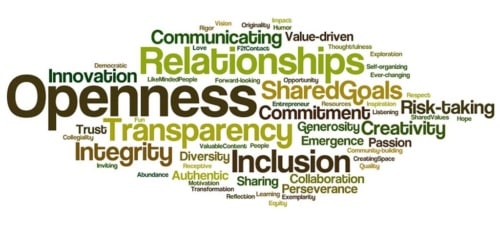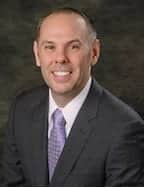Greg Little likes to talk about journeys when speaking about education. As Superintendent of Lexington School District One in South Carolina, he has certainly taken his own journey to get to the position he finds himself in today. 
Greg strives to bring personalization to the journeys of his students. Greg explains, “Our students need to create their own realities in learning. They can problem solve and do projects that they can really get their teeth into.” As superintendent, Little is working on programs and policies that will encourage student ownership across his district.
Little also talks about shaking up the status quo regarding letter or percentage grades and brings insight into what those grades actually mean. Part of the problem, according to Greg, comes from the fact that letter grades are so ingrained in our society that proposing change almost always poses a problem. It’s important that school leadership work to provide a clear message to parents and the community to create necessary buy-in.
The interview revealed that it takes a special nuance to persuade people to adopt sweeping change – a characteristic that the congenial Greg Little clearly possesses.
Interview
Dr. Berger: Greg, I’ve been having conversations with superintendents around some of the larger issues that many are facing and some of the conversations, I would imagine, you’re having probably amongst yourselves.
One area that I’m finding more and more of us talking about is around funding and alternative ways to bring in funding that can offset challenges that we might have in the district level.
I’m also hearing the layer of “if we’re going to incorporate corporate America or just the private sector in some form or fashion, that there is a cultural shift of acceptance in trying to find ways to do that so that we are not sort of separating, because we fear there’s church-and-state kind of approach or thought process.”
How do you look at that at your district when you think about your local community not just from a human-resources opportunity but from funding or alternative ways to support your district?
Dr. Greg Little: We have great partnerships. Michelin, for example, is one of our great partners. We’ve looked for different ways to include them in what we’re trying to do and to create opportunities for them to get behind projects that they’re excited about as well because it is a partnership; it’s a two-way street.
It’s not just us saying, “Hey, we’d like for you to be involved.” It’s also they being involved in projects that they can be pretty excited about and get behind.
And we are very thankful to our corporate sponsors.
So far, we’ve only had that, though, in specific silos. It’s a really specific niche projects and those kinds of things whether it be a STEM lab or volunteers to come read to our students ─ that kind of thing.
It’s not even about dollars, necessarily, all the time. It’s also about time and their employees giving back in volunteer hours ─ those kinds of things. And that has been very successful as well.
But, so far, we’ve not looked at that as a wide-ranging funding strategy. It is more of a niche market with specific projects that the corporations can get excited about.
DB: Speaking of research and support, let’s take a trip down the teacher lane, when we think about providing resources in a world where their job is changing all the time, as I’m sure yours is as a superintendent.
We’re finding that the students of today are very different. We went from that sort of consumer model of the student to a creator from our youngest students all the way up to our high school graduates. That seems to, then, change what we need to do in supporting our teachers from a professional learning and professional development perspective.
How do you talk about that and think about that as a leader and a leadership team within your district? 
GL: That is a fantastic question. I definitely think that the role of the teacher has shifted from the sage on the stage; and, now, we went to the guide on the side.
But, really, I feel like it has evolved even beyond that as well because in order for our students to create their own realities or their own learning and really problem solve and do projects and problems that they can really get their teeth into, our teachers made a lot of specialized training around how to do that.
It’s not just rolling the basketball out and just letting the kids play. It’s a very structured environment.
I’ll give you a great example. When I was in North Carolina, we created this grant opportunity that helped our teachers become trained in problem-based and project-based learning. And it was one of the most intensive professional development experiences I’ve ever seen.
One issue about professional development is that we have to get out of the business of one afternoon, one day a month.
If we want transformational learning opportunities for our teachers, we have to invest in that time ─ two to three weeks of coaching opportunities for them to get together, opportunities for them to practice what they’re learning on their students and report back.
It’s a much different experience today than it was. The two days right before school starts, “Let’s have an in-service” or that one week a month where we take an afternoon and do something. It’s got to be more expansive than that.
DB: Do you find in that same vein that when you think about the technologies that are supporting these different pieces that you’re talking about, and that we’re implementing in classrooms, and the professional development that ride alongside that, that you were making different decisions from a district level that personalizes at the different levels of students of where they are at their age?
I think, to your point, that sort of blanket cattle call that we had for PD for years has also started with our technologies as well. “Look, here’s a technology and we’ll just put some bells and whistles for the younger students but it’s really more catered for the high school.”
But it seems like we’re also trying to fix that as well. Are you seeing that?
GL: We pride ourselves for trying to create a personalized journey for our students. And we’re working even to rethink graduation credits and all those situations because we talk about personalized experience but you’re required to have these same 24 credits.
That’s not a personalized journey; that’s the same 24 credits everybody else has. So it’s the exact same thing.
And it’s hard to do that. It’s hard work. It’s hard to find the right kind of people to do that. Oftentimes, I find it more expensive to do that. You have to build capacity to do that. And one of the hardest parts about building capacity is that the one constant in education is change.
So just the time you create capacity in a teacher ─ his wife takes a new job in another town and he has to transfer; or they become a principal or they do something different. And then, you have to figure out how to sustain that over time.
That’s actually one of the biggest challenges you’ll find building capacity in people and sustaining that capacity in your organization.
It is challenging work but it is also exciting work, too, because that’s really where we’re going. We are out of the factory model, and we’re into the idea of child, as they go through K-12, crafting their own path and creating their own journey.
DB: Greg, let’s go to their own journey ─ that part of it. There’s a lot that’s being talked about around the student’s ownership of their learning, the results that come from that and the way in which we look at grading and reporting in these different things and then documenting it really more, broadly speaking.
How do you look at it when it comes to taking that experience and knowing that we’ve got, now, creators and not consumers as students; that we’re trying to provide ownership for them where they can take control of their learning?
If we, then, complete that and say, “Okay, we need to communicate that out.” How do we do that on a regular basis in a way that is supportive and that provides enough touch points where everybody feels engaged and involved in the learning process and, ultimately, the student is supported in their ownership? 
GL: There are a couple of ways. I think, number one, we have to create a classroom environment that fosters the child to take control of their own learning.
We talk about that a lot but, then, for example, we give them all the materials they need for a lab. So we run a lab situation and we lay it all out for them; we give them a script to go by; and so, we’ve taken this great hands-on thoughtful experience, and we’ve turned it into a recipe where all you have to do is follow each step as you go and you’re going to come out where you need to be.
That’s the first thing. We’ve got to think about the classroom experience ─ number one, that we’re not dumbing down experiences that could be very powerful for our students.
The second thing is that you talked about grading and you talked about reporting those grades. We’ve done a lot with student-led conferences and I’ve been fortunate enough to sit in on a couple of them; and it’s fantastic to see the parent and the child interacting in a different way ─ not just “What did you do today?”
“Nothing.”
Those are the kinds of experiences that you have around the dinner table. But watching the children interact with their parents even as a high schoolers, it’s interesting to see that conversation.
I think the third thing is that we continue to have problems with grades and what a grade is. What’s an 87? What does an 87 tell me?
But it’s interesting how people cling to that notion. So when we talk about standards-based grading or some type of competency-based grading, people will still cling to that notion that “No, I want them to get an A, B, C, D or an F, so they’ll be prepared for middle school.”
Somehow, this grading is a magic elixir that if we give to them, they’ll be more prepared for middle school. It’s absolutely fascinating to me that we still cling to those notions.
DB: And yet, in the world that they’re going to enter when they, then, go on to college and a career, the work world does not think about grades in the way in which they did when we were going to school.
GL: Right. They’re interested in your interpersonal skills. We’ve created habits of scholarship and leadership-trait-type reporting systems that I think are pretty powerful; and kids talk a lot about that. And we’re really working to create a habits of scholarship issue because that’s the lesson we want them to have.
They’re going to forget the 90 that they made on whatever the Romeo and Juliet, Act 1 test in the ninth grade. But they’re not going to forget the lessons associated with the perseverance, the grit, or the determination. Those are the lessons that they’ll actually take with them and can apply in those situations.
DB: Let’s close with this. I think there are a lot of misconceptions at the community level about who and what a superintendent is and what it takes to be a superintendent just from a personality-access level.
Take us inside the conversations that you’ve had just in the general with your professional colleagues from other districts. What should we know as parents and community members about the personalities driving district leadership, that may or may not be true? I just think that there are these myths out there, things that maybe years ago was the “ivory tower” and it’s not. 
GL: I think what you see is the colleagues that I’ve met in two different states now ─ North Carolina and South Carolina ─ is, by and large, superintendents care deeply about children.
I think the myth is “Oh, you’re a CEO or you’re a businessman or this kind of thing.”
And I’ll tell you, that’s now who I am. I’m still the seventh-grade language arts teacher who started in Durham and who care about kids in making a difference in the lives of kids.
And I think when I talk to my colleagues that they have a deep passion and a care to see children be successful. I was just talking to somebody a moment ago and he says, “You know, we are really transforming lives.”
And that’s what we want to do as superintendents. And I tell kids when I visit classroom ─ and I have visited, so far, 25 schools this year and over 1500 classrooms. They ask me all the time, “So what does a superintendent do? What do you try to do as a superintendent?”
And I tell them that my number one priority is their success. And that’s something that I think drives us, as superintendents, because this work is very difficult and it’s very stressful.
If we don’t hold that flame, if we don’t keep that candle burning about why we do this ─ and it’s because we want to make a difference in the lives of the students ─ there’s no way we would make it through the course of the day if we didn’t keep that burning.
About Dr. Greg Little
 Raised in a family of educators and a veteran educator with 18 years of experience, Greg Little originally graduated in 1997 from the University of North Carolina at Wilmington with a Bachelor of Arts in English. Seven years later he earned a Master of Arts in curriculum and instruction, followed by a Doctor of Education in curriculum and instruction, both from the University of North Carolina at Chapel Hill.
Raised in a family of educators and a veteran educator with 18 years of experience, Greg Little originally graduated in 1997 from the University of North Carolina at Wilmington with a Bachelor of Arts in English. Seven years later he earned a Master of Arts in curriculum and instruction, followed by a Doctor of Education in curriculum and instruction, both from the University of North Carolina at Chapel Hill.
He began his career as a secondary English language arts instructor in Durham Public Schools in Durham, North Carolina, where he planned and implemented curriculum for middle and high school students, and developed a creative writing curriculum and study skills curriculum for high school students.
He moved to the Wake County Public School System in Raleigh in 2004 as senior administrator of middle school English language arts and led district-wide writing instruction and reading.
In 2006, he became assistant superintendent of K–12 curriculum and instruction for Roanoke Rapids Graded School District in North Carolina where he budgeted and administered a wide range of K–12 curriculum and instruction programs, including career and technical education, academically/intellectually gifted, media centers, English as a second language, 504s, textbook adoption, homebound instruction, Title II, etc. and served as a Federal grant reviewer.
He is currently the superintendent at the Lexington School District One in South Carolina.
Follow Dr. Greg Little on Twitter
This article was originally published in the Huffington Post
AuthorDr. Berger is one of many industry education correspondents for the Mind Rocket Media Group, An educator and former school administrator. His video interview work and conversational podcasts have been featured in various media outlets. He often hosts education panel discussions and develops strategic content. As an academic Dr. Berger is a guest lecturer at Vanderbilt University’s Owen Graduate School of Management. A former assistant principal, he has been an adjunct undergraduate professor and developer of online college courses. He is a passionate Detroit sports fan who has also adopted Nashville sports teams as his own.
Contact the Mind Rocket Media Group if you are interested in an industry interview and a placement on EdCircuit.
Further Reading
- The Atlantic – Will Personalized Learning Become the New Normal?
- Education Week – Personalized Learning: What Does the Research Say?
- Chicago Business – Why aren’t more Chicago businesses adopting schools?


